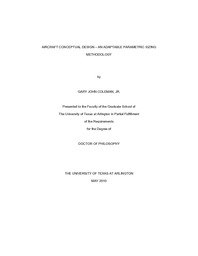
ATTENTION: The works hosted here are being migrated to a new repository that will consolidate resources, improve discoverability, and better show UTA's research impact on the global community. We will update authors as the migration progresses. Please see MavMatrix for more information.
Show simple item record
| dc.contributor.author | Coleman, Gary John | en_US |
| dc.date.accessioned | 2010-07-19T19:55:04Z | |
| dc.date.available | 2010-07-19T19:55:04Z | |
| dc.date.issued | 2010-07-19 | |
| dc.date.submitted | January 2010 | en_US |
| dc.identifier.other | DISS-10687 | en_US |
| dc.identifier.uri | http://hdl.handle.net/10106/4951 | |
| dc.description.abstract | Aerospace is a maturing industry with successful and refined baselines which work well for traditional baseline missions, markets and technologies. However, when new markets (space tourism) or new constrains (environmental) or new technologies (composite, natural laminar flow) emerge, the conventional solution is not necessarily best for the new situation. Which begs the question "how does a design team quickly screen and compare novel solutions to conventional solutions for new aerospace challenges?" The answer is rapid and flexible conceptual design Parametric Sizing. In the product design life-cycle, parametric sizing is the first step in screening the total vehicle in terms of mission, configuration and technology to quickly assess first order design and mission sensitivities. During this phase, various missions and technologies are assessed. During this phase, the designer is identifying design solutions of concepts and configurations to meet combinations of mission and technology. This research undertaking contributes the state-of-the-art in aircraft parametric sizing through (1) development of a dedicated conceptual design process and disciplinary methods library, (2) development of a novel and robust parametric sizing process based on `best-practice' approaches found in the process and disciplinary methods library, and (3) application of the parametric sizing process to a variety of design missions (transonic, supersonic and hypersonic transports), different configurations (tail-aft, blended wing body, strut-braced wing, hypersonic blended bodies, etc.), and different technologies (composite, natural laminar flow, thrust vectored control, etc.), in order to demonstrate the robustness of the methodology and unearth first-order design sensitivities to current and future aerospace design problems.This research undertaking demonstrates the importance of this early design step in selecting the correct combination of mission, technologies and configuration to meet current aerospace challenges. Overarching goal is to avoid the reoccurring situation of optimizing an already ill-fated solution. | en_US |
| dc.description.sponsorship | Chudoba, Bernd | en_US |
| dc.language.iso | EN | en_US |
| dc.publisher | Aerospace Engineering | en_US |
| dc.title | Aircraft Conceptual Design - An Adaptable Parametric Sizing Methodology | en_US |
| dc.type | Ph.D. | en_US |
| dc.contributor.committeeChair | Chudoba, Bernd | en_US |
| dc.degree.department | Aerospace Engineering | en_US |
| dc.degree.discipline | Aerospace Engineering | en_US |
| dc.degree.grantor | University of Texas at Arlington | en_US |
| dc.degree.level | doctoral | en_US |
| dc.degree.name | Ph.D. | en_US |
| dc.identifier.externalLink | https://www.uta.edu/ra/real/editprofile.php?onlyview=1&pid=1187 | |
| dc.identifier.externalLinkDescription | Link to Research Profiles | |
Files in this item
- Name:
- Coleman_uta_2502D_10687.pdf
- Size:
- 37.82Mb
- Format:
- PDF
This item appears in the following Collection(s)
Show simple item record


